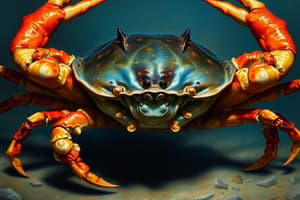Podcast
Questions and Answers
How long have American horseshoe crabs been around compared to dinosaurs?
How long have American horseshoe crabs been around compared to dinosaurs?
- They were the first crabs to evolve after dinosaurs.
- They emerged at the same time as dinosaurs.
- They appeared 200 million years after dinosaurs.
- They have existed for 200 million years longer than dinosaurs. (correct)
What is the primary function of the photoreceptors located on the tail of the American horseshoe crab?
What is the primary function of the photoreceptors located on the tail of the American horseshoe crab?
- To locate food sources.
- To identify predators.
- To help regulate their body clock. (correct)
- To help them see their surroundings.
What color is the blood of an American horseshoe crab when exposed to air?
What color is the blood of an American horseshoe crab when exposed to air?
- Green due to chlorophyll.
- Yellowish due to high sodium content.
- Red like human blood.
- Bright blue because of its copper base. (correct)
What type of food do American horseshoe crabs primarily eat?
What type of food do American horseshoe crabs primarily eat?
How often do American horseshoe crabs typically molt before reaching adulthood?
How often do American horseshoe crabs typically molt before reaching adulthood?
Flashcards
What protects the American horseshoe crab?
What protects the American horseshoe crab?
American horseshoe crabs have a hard outer shell called an exoskeleton that protects them. This shell is shed as the crab grows, a process called molting. They can molt up to 17 times before reaching full size.
How many eyes does an American horseshoe crab have?
How many eyes does an American horseshoe crab have?
American horseshoe crabs have 10 eyes! Some are on top of their shell, some are on the bottom, and even the tail helps with light sensitivity.
How does an American horseshoe crab eat?
How does an American horseshoe crab eat?
They use their legs to crush food, and their pincers to bring the food to their mouths.
What is unique about the blood of an American horseshoe crab?
What is unique about the blood of an American horseshoe crab?
Signup and view all the flashcards
How long have American horseshoe crabs existed?
How long have American horseshoe crabs existed?
Signup and view all the flashcards
Study Notes
American Horseshoe Crab
- Ancient species: Existed 450 million years ago, before dinosaurs.
- Crawling on ocean floor: Long-lived, currently existing.
- Protective exoskeleton: Tank-like shell, molts multiple times as it grows.
- Feeding: Grinds food with legs, uses pincers to feed, eats invertebrates (e.g., worms).
- Ten eyes: Some on top of shell, some on underside, including photoreceptors on tail.
- Photoreceptors: Tail photoreceptors regulate body clock, react to changes in light (helpful for nocturnal feeding).
- Blue blood: Copper-based, unique color; clotting mechanisms protect from toxins.
- Immune cells: Highly sensitive to toxins; used in vaccine testing to identify contamination.
Studying That Suits You
Use AI to generate personalized quizzes and flashcards to suit your learning preferences.



